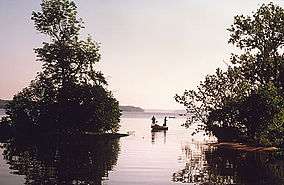Piscataway Park
| Piscataway Park | |
|---|---|
|
IUCN category V (protected landscape/seascape) | |
|
View of the Potomac River at Piscataway Park | |
 | |
| Location | Prince George's County, Maryland, USA |
| Nearest city | Accokeek, MD |
| Coordinates | 38°40′43″N 77°05′34″W / 38.67861°N 77.09278°WCoordinates: 38°40′43″N 77°05′34″W / 38.67861°N 77.09278°W |
| Established | October 4, 1961 |
| Visitors | 176,174 (in 2005) |
| Governing body | |
|
Piscataway Park | |
  | |
| Nearest city | Accokeek, Maryland |
| Area | 4,216.5 acres (1,706.4 ha) |
| NRHP Reference # | 66000144[1] |
| Added to NRHP | October 15, 1966 |
Piscataway Park, located 20 miles (32 km) southwest of downtown Washington, D.C., in and around Accokeek, Maryland, protects Marshall Hall the National Colonial Farm, and the Accokeek Creek Site. The park is located across the Potomac River from George Washington's Mount Vernon estate.
Piscataway Park is named after Piscataway Creek, itself named for a Native American tribe. The park is home to bald eagles, beavers, osprey, and other wildlife[2] and encompasses areas of wetland, meadow and woodland. It is administered by the National Park Service and is managed by National Capital Parks-East.[3]
History
In the mid-1950s, development threatened to destroy the beautiful landscape along the Maryland shore of the Potomac River. Instead of enjoying the same view that George Washington did more than two hundred years ago, visitors to George Washington’s Mount Vernon Estate would have seen an oil tank farm, a sewage treatment plant, or housing developments.
Congresswoman Frances Payne Bolton of Ohio, a member of the Mount Vernon Ladies’ Association, sprang into action. She purchased a 500-acre farm directly across the Potomac from Mount Vernon and next to the Moyaone Reserve, an environmentally conscious planned community. Bolton donated her farm for the creation of the Accokeek Foundation and, with a coalition of organizations that included the Alice Ferguson Foundation, Moyaone Association, and Mount Vernon Ladies’ Association, launched an ambitious program to protect six-miles of shoreline. This large-scale landscape conservation effort led to the creation of Piscataway Park, the first national park established to “preserve historic vistas.”
Today, the Accokeek Foundation partners with the National Park Service to steward 200 acres of Piscataway Park which covers, in total, approximately 5,000 acres, from Piscataway Creek to Marshall Hall on the Potomac River. An effort that began out of a desire to “preserve the view,” in the end has preserved much more. The full conservation area protects a wealth of environmental, cultural, and historic resources, from wetlands to farms to nationally significant historic sites.
The park is open daily to visitors who enjoy a quiet landscape for recreation and reflection. Annually, thousands of school children visit for farm-based education, learning about environmental stewardship through a historical lens. With support from donors and members, the Accokeek Foundation provides a natural space for all to enjoy, for generations to come.
National Colonial Farm
The National Colonial Farm is a historic farm museum established by the Accokeek Foundation in 1958. The farm demonstrates 18th century agriculture by preserving rare breed of animals and crops. Structures located within the farm site are open to the public and include a circa 1770 farm dwelling, an 18th century tobacco barn, and an out-kitchen. Costumed interpreters are available on the farm during the season (March - December) on the weekends to help guide the visitor experience as they show you how the typical tobacco farming family might have lived in Maryland. The National Colonial Farm is open daily, and there is no general admission fee except during special events. School and specialty group tour reservations can be made throughout the year.
References
- ↑ National Park Service (2010-07-09). "National Register Information System". National Register of Historic Places. National Park Service.
- ↑ "Piscataway Park". Accokeek Foundation.
- ↑ "Piscataway Park". National Park Service. Retrieved June 2, 2011.
External links
- Piscataway Park, Prince George's County, Inventory No.: PG:83-12, CH-668, including photo, at Maryland Historical Trust website
- National Park Service Piscataway Park official website
- "Piscataway Park" – Chesapeake Bay Gateways Network


